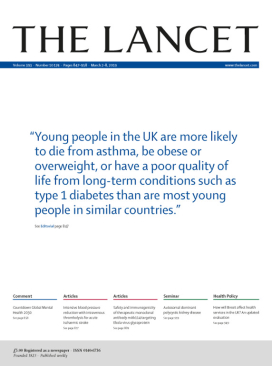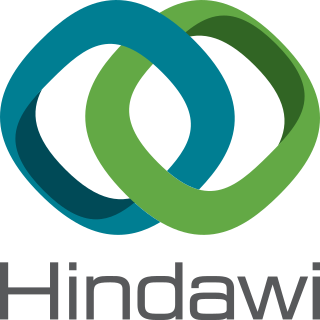
In academic publishing, a scientific journal is a periodical publication intended to further the progress of science, usually by sharing findings from research with readers. They are normally specialized based on discipline, with authors picking which one they send their manuscripts to.

Academic publishing is the subfield of publishing which distributes academic research and scholarship. Most academic work is published in academic journal articles, books or thesis. The part of academic written output that is not formally published but merely printed up or posted on the Internet is often called "grey literature". Most scientific and scholarly journals, and many academic and scholarly books, though not all, are based on some form of peer review or editorial refereeing to qualify texts for publication. Peer review quality and selectivity standards vary greatly from journal to journal, publisher to publisher, and field to field.

The Lancet is a weekly peer-reviewed general medical journal and one of the oldest of its kind. It is also the world's highest-impact academic journal. It was founded in England in 1823.
In academic publishing, a retraction is a mechanism by which a published paper in an academic journal is flagged for being seriously flawed to the extent that their results and conclusions can no longer be relied upon. Retracted articles are not removed from the published literature but marked as retracted. In some cases it may be necessary to remove an article from publication, such as when the article is clearly defamatory, violates personal privacy, is the subject of a court order, or might pose a serious health risk to the general public.
PLOS Computational Biology is a monthly peer-reviewed open access scientific journal covering computational biology. It was established in 2005 by the Public Library of Science in association with the International Society for Computational Biology (ISCB) in the same format as the previously established PLOS Biology and PLOS Medicine. The founding editor-in-chief was Philip Bourne and the current ones are Feilim Mac Gabhann and Jason Papin.

Hindawi is a publisher of peer-reviewed, open access, scientific journals currently active in scientific, technical, and medical (STM) literature. It was founded in 1997 in Cairo, Egypt, and purchased in 2021 for $298 million by John Wiley & Sons, a large US-based publishing company. The publisher has been classified as a predatory publisher. After almost 10,000 article retractions in 2023, Wiley announced that it would cease using the Hindawi brand.
MDPI is a publisher of open-access scientific journals. It publishes over 390 peer-reviewed, open access journals. MDPI is among the largest publishers in the world in terms of journal article output, and is the largest publisher of open access articles.
Journal of Physics: Conference Series (JPCS) is a peer-reviewed, open-access publication from IOP Publishing providing readers with the latest developments in physics presented at international conferences.
Open peer review is the various possible modifications of the traditional scholarly peer review process. The three most common modifications to which the term is applied are:
- Open identities: Authors and reviewers are aware of each other's identity.
- Open reports: Review reports are published alongside the relevant article.
- Open participation: The wider community are able to contribute to the review process.

Virology Journal is an open-access peer-reviewed medical journal published by BioMed Central. It publishes research related to viruses and the prevention of viral infection. The journal was established in 2004 with Robert Garry as founding editor-in-chief and has been edited by Linfa Wang since 2012. It aims to cover rapid communications amongst virologists.
Scientific Reports is a peer-reviewed open-access scientific mega journal published by Nature Portfolio, covering all areas of the natural sciences. The journal was established in 2011. The journal states that their aim is to assess solely the scientific validity of a submitted paper, rather than its perceived importance, significance, or impact.
Scholarly peer review or academic peer review is the process of having a draft version of a researcher's methods and findings reviewed by experts in the same field. Peer review is widely used for helping the academic publisher decide whether the work should be accepted, considered acceptable with revisions, or rejected for official publication in an academic journal, a monograph or in the proceedings of an academic conference. If the identities of authors are not revealed to each other, the procedure is called dual-anonymous peer review.
Frontiers Media SA is a publisher of peer-reviewed, open access, scientific journals currently active in science, technology, and medicine. It was founded in 2007 by Kamila and Henry Markram. Frontiers is based in Lausanne, Switzerland, with other offices in the United Kingdom, Spain, and China. In 2022, Frontiers employed more than 1,400 people, across 14 countries. All Frontiers journals are published under a Creative Commons Attribution License.

PeerJ is an open access peer-reviewed scientific mega journal covering research in the biological and medical sciences. It is published by a company of the same name that was co-founded by CEO Jason Hoyt and publisher Peter Binfield, with initial financial backing of US$950,000 from O'Reilly Media's O'Reilly AlphaTech Ventures, and later funding from Sage Publishing.

Predatory publishing, also write-only publishing or deceptive publishing, is an exploitative academic publishing business model that involves charging publication fees to authors while only superficially checking articles for quality and legitimacy, and without providing editorial and publishing services that legitimate academic journals provide, whether open access or not. The rejection rate of predatory journals is low, but seldom zero. The phenomenon of "open access predatory publishers" was first noticed by Jeffrey Beall, when he described "publishers that are ready to publish any article for payment". However, criticisms about the label "predatory" have been raised. A lengthy review of the controversy started by Beall appears in The Journal of Academic Librarianship.

"Who's Afraid of Peer Review?" is an article written by Science correspondent John Bohannon that describes his investigation of peer review among fee-charging open-access journals. Between January and August 2013, Bohannon submitted fake scientific papers to 304 journals owned by fee-charging open access publishers. The papers, writes Bohannon, "were designed with such grave and obvious scientific flaws that they should have been rejected immediately by editors and peer reviewers", but 60% of the journals accepted them. The article and associated data were published in the 4 October 2013 issue of Science as open access.
A mega journal is a peer-reviewed academic open access journal designed to be much larger than a traditional journal by exercising low selectivity among accepted articles. It was pioneered by PLOS ONE. This "very lucrative publishing model" was soon emulated by other publishers.
Tumor Biology is a bimonthly peer-reviewed open access medical journal covering clinical and experimental oncology. It was established in 1980 as Oncodevelopmental Biology and Medicine, obtaining its current name in 1984. It is owned by the International Society of Oncology and BioMarkers, of which it is the official journal. Originally published by Karger Publishers, it moved to Springer Science+Business Media beginning in 2010. In December 2016, the journal moved again, this time to SAGE Publications. The editor-in-chief is Magdalena Chechlinska. According to the Journal Citation Reports, the journal has a 2016 impact factor of 3.650.

Conflicts of interest (COIs) often arise in academic publishing. Such conflicts may cause wrongdoing and make it more likely. Ethical standards in academic publishing exist to avoid and deal with conflicts of interest, and the field continues to develop new standards. Standards vary between journals and are unevenly applied. According to the International Committee of Medical Journal Editors, "[a]uthors have a responsibility to evaluate the integrity, history, practices and reputation of the journals to which they submit manuscripts".
Controversy surrounds the concept of rapid-onset gender dysphoria (ROGD), a scientifically unsupported proposed subtype of gender dysphoria said to be caused by peer influence and social contagion. ROGD has not been recognized by any major professional association as a valid mental health diagnosis, and use of the term has been discouraged by professional and academic institutions due to a lack of reputable scientific evidence, major methodological issues in existing research, and likelihood to cause harm by stigmatizing gender-affirming care.










